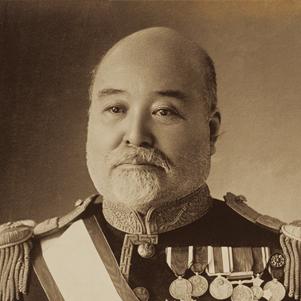English training at Yokohama’s Hepburn Academy

Korekiyo Takahashi
1854-1936
Sold into slavery in a foreign country due to his unwittingly signing an indenture. Convinced to invest his entire fortune in an apparently promising silver mine, only to end up bankrupt. Dismissed from his job because of his fondness for alcohol and carousing . . .
Korekiyo Takahashi led a checkered life with many failures. However, people extended a helping hand to him each time and when others sought his assistance, he repaid their trust by ensuring that he achieved positive results. Korekiyo Takahashi’s life leaves a profound and lasting impression on us.
Amassing 900 million yen singlehandedly
Korekiyo was still just 11 years old when he began attending the Hepburn Academy. He spent two years here studying English before sailing to the U.S. at the age of 14, again on the orders of the domain authorities. Having suffered the terrible experience of being sold into slavery after being deceived by his homestay family, he eventually made it back to Japan, only to find that the Sendai Domain had been abolished in the wake of the Meiji Restoration! While he managed to get by as a student while carrying out housework in exchange for meals and lodging, and then subsequently as a teaching assistant, he had a natural inclination toward drinking and carousing. He ended up losing his job because of his debauched lifestyle.
The fact that various people sought to help him nonetheless suggests that Korekiyo was a man of tremendous personal magnetism. Through his connections, he found employment at the Ministry of Education and the Ministry of Agriculture and Commerce. Following his subsequent disastrous venture into running a silver mine in Peru, he joined the Bank of Japan, rising to the rank of vice president. It was around then that he was asked to take on the formidable task of selling Japanese Government Bonds overseas to fund Japan’s expenditure on its war with Russia. Covered in Ryotaro Shiba’s novel Clouds Above the Hill, this episode is still well known today.
He must have had astonishingly good negotiating skills, as he managed to amass approximately 900 million yen—a vast sum of money in those days—by selling bonds issued by the government of Japan, even though the country had only just opened up to the rest of the world and had not even earned the trust of its neighbors. After the Russo-Japanese War ended, he laid the foundations of the Japanese economy with his characteristic expansionary fiscal policy as Governor of the Bank of Japan and Minister of Finance. He also made a significant contribution to the nation’s economic recovery in the wake of the Showa Depression, but came to be regarded as an enemy by the military, because he sought to cut defense expenditure as part of the belt-tightening measures he advocated to curb inflation. Naturally, he was not the kind of person to flinch in the face of opposition. However, this led to the tragedy of Korekiyo Takahashi’s assassination in the February 26 Incident.
Doing the jobs asked of him
Over the course of this varied career, Korekiyo held a succession of important government posts and people always asked him to do things for them. Once asked, he always strove hard to fully meet their request. This was the nature of his passive personality. He was always optimistic, smiling as he said, “If you give your all when you undertake things, the way will open up without fail,” and giving his utmost as he simply did the jobs asked of him. This was typical of how Korekiyo lived his life.
When he was asked to do something, he spared no effort, trusting that, since people had requested it of him, doing the work would bring its own reward, and accepting words of gratitude in return. Indeed, give and take of this kind might perhaps be the archetype for living life as a member of society. In that sense, Korekiyo Takahashi appears to have been a man who valued life.
[References]
Autobiography of Korekiyo Takahashi (vols. 1 and 2), (Chuko Bunko)
[Photograph]
National Diet Library Digital Archive
